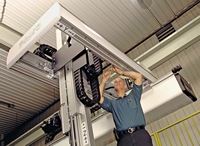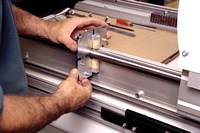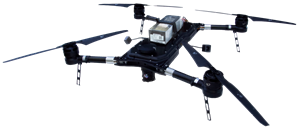Eight Tips on Robot Maintenance
Beam-mounted Cartesian robots are usually installed in applications where availability and maximum uptime are primary concerns.
Beam-mounted Cartesian robots are usually installed in applications where availability and maximum uptime are primary concerns. It is important for operators to detect signs that maintenance is required, because unplanned downtime disrupts production, is almost always time-consuming, and can add costs by requiring labor overtime or rush shipment of a replacement part. Paying consistent attention to a few important operational conditions will, in the long run, result in less downtime and lower costs.
1. WATCH THE ROBOT CYCLE
One of the keys to keeping robots in good condition involves simply watching and listening, which can reveal a lot about the robot’s general condition. As the robot runs through its motions, listen for any unusual sounds, like squeaking or knocking. This can indicate that a bearing is not rotating properly or that some other component is binding. Robots have a normal clicking sound from the motion of links in the track that carries the motor cables and vacuum hoses, but the motions should be smooth and quiet. Inspect any bearings that are visible and make sure they are turning smoothly.
2. EXAMINE RAILS & BEARINGS
The guiding rails and bearings on all axes should be kept clean and well lubricated. If the robot is being operated in a dusty environment, clean the rails frequently. If you see any metal chips or fines, that can indicate poor lubrication. To ensure correct lubrication, which is critical to the proper functioning of the linear guiding system, most robots have an automatic lubrication system with components that need to be replaced periodically. See below for more details.
3. DRIVE SYSTEM TESTING
If the robot has a rack-and-pinion drive, take note if there is any hesitation or jerking during operation. Anything other than a smooth and quiet motion can indicate damage to the drive system or some foreign object lodged in it.
When the robot is powered down, a quick way to check for play or backlash between the rack and pinion is to push and tug on the robot mobile and feel for abnormal movement (unequal play back and forth). However, since normal manufacturers’ tolerances are quite tight, this test method can be highly inexact.
If you suspect there may be a problem with the rack and pinion, a better approach is to use a magnetic stand with a long-range indicator. After adjusting the backlash to the manufacturer’s specification, check the whole range of the axis to ensure there are no tight spots between the rack and pinion.
If the backlash cannot be adjusted, both rack and pinion may be worn and need to be replaced. If it is necessary to repair the rack and pinion, it is best to replace both components at the same time to ensure long-term performance.
On belt-driven axes, watch out for fraying or damage to the belt itself. Look around the pulleys for signs of dust coming from the belt material. Make sure the belt is properly aligned on the pulleys and sheaves. A misaligned belt will wear very quickly. And whenever working on a belt-drive system, check the pre-load of the belt itself, following the manufacturer’s specifications. These specs will tell you how much deflection is normal at a particular position on the belt, relative to the pulley.
4. INSPECT THE PNEUMATIC SYSTEM
Almost every robot, even those with multi-axis servo drive, will probably have pneumatic functions, if only for wrist rotation or vacuum gripping of parts. Keep an eye on the bowl of the filter regulator unit. Accumulated water in the bowl indicates that there is excess moisture in the shop air going through the system. Even a small amount of moisture can get transported to the pneumatic valves and actuators, causing oxidation or build-up of contamination, which may eventually cause the valves to stick or the actuators to bind and fail intermittently. Even if the bowl has an automatic moisture evacuation system, stains or discoloration of the bowl indicate that moisture is building up before it is evacuated. As moisture accumulates in the bowl, even for a short time, it can get drawn into the system, causing the problems cited above.
If you notice any physical damage to the pneumatic hoses, there may be a leak in the system. If a pneumatic circuit is charged with air at normal operating pressures and there is a leak somewhere in the circuit, you should easily notice a pronounced hissing sound that will help you locate the leak.
5. CHECK VACUUM GRIPPER CIRCUITS
Vacuum should build almost instantaneously and the appropriate controller input should come on to indicate that the part is gripped. If you observe a delay of more than 2 seconds from when the vacuum is turned on and the input light comes on, this indicates either a vacuum-line leak or a faulty or poorly adjusted switch. These tests can be performed easily from the main control pendant. When the robot has digital vacuum switches, fine-tuning the minimum vacuum threshold required to grip the part is instant and automatic. This procedure can be completed while the robot is operating in automatic mode. The settings for each production run are stored in memory, which can save time at the next production change. Digital vacuum switches also offer two other advantages:
•An electronic filter on the gripping threshold signal compensates for vibration of the parts on the vacuum cups during fast movements.
•A part-release threshold with a different value than the gripping threshold can be programmed to make sure that the parts are properly released during fast cycles.
6. CHECK WIRING FOR WEAR
Black particles or fines found during inspection of the robot surfaces may indicate wear in the robot’s electrical wiring. But, even if you don’t notice these telltale signs of wear, look carefully at all power, resolver, or encoder cables, both inside outside of the wiring tracks. Wiring that continually rubs against the robot during cycling, or that gets bound up in the cable tracks, will eventually wear and fail. Make sure that tie-wraps are secure and that they restrain the cables properly.
7. INSPECT LUBRICATION
Robots employ spring-loaded grease sticks, and unless there is some evidence that the guiding rails are not being adequately lubricated, these need to be replaced only once a year. With automatic systems, lubrication occurs continually as the robot moves. However, if there are surfaces over which the robot does not move on a regular basis, these areas need to be lubricated either manually or by periodically programming movement that allows the automatic system to lubricate them. If you notice rust, pitting, or wear on any moving surfaces, or if they are simply dry, they have not been properly lubricated. Always refer to the robot manual for the appropriate lubrication of metal components. Rack-and-pinion systems have automatic lubrication from a reservoir, which needs to be replaced every year.
8. WATCH THE MOLDING MACHINE
In a standard configuration, a robot is usually installed on the platen of the molding machine. When the machine is running on a fast cycle, vibrations from the press can be transmitted to the robot and this can be detrimental.
Robot life can easily be extended by simply watching the operation of the molding machine and making sure the mold movements are properly adjusted to limit the amount of jerking or vibration. In case of very fast cycles, where vibration levels can be very high, it is best to install the robot on a supporting structure that is independent of the molding machine.
About the Author
Loïc Legendre recently was promoted to v.p.-service for Sepro America LLC in Pittsburgh. He had been service manager since the company was formed in 2007 and before that worked for two decades at Sepro Robotique in France. Contact him at (412) 459-0462 or llegendre@seproamerica.com.
Related Content
NPE2024 Wrap-Up: Sustainability Dominates Show Floor News
Across all process types, sustainability was a big theme at NPE2024. But there was plenty to see in automation and artificial intelligence as well.
Read MoreWhat to Look for in High-Speed Automation for Pipette Production
Automation is a must-have for molders of pipettes. Make sure your supplier provides assurances of throughput and output, manpower utilization, floor space consumption and payback period.
Read MoreICIS Launches: Ask ICIS Generative AI Commodities Assistant
Said to be the first of its kind, this AI assistant will enhance access to ICIS’ intelligence and insights for the energy and chemical markets.
Read MoreDrones and Injection Molding Ready for Takeoff
Drones and unmanned aerial vehicles (UAV) are approaching an inflection point where their production volumes — and functionality — will increasingly point to injection molding.
Read MoreRead Next
Beyond Prototypes: 8 Ways the Plastics Industry Is Using 3D Printing
Plastics processors are finding applications for 3D printing around the plant and across the supply chain. Here are 8 examples to look for at NPE2024.
Read MoreSee Recyclers Close the Loop on Trade Show Production Scrap at NPE2024
A collaboration between show organizer PLASTICS, recycler CPR and size reduction experts WEIMA and Conair recovered and recycled all production scrap at NPE2024.
Read MoreFor PLASTICS' CEO Seaholm, NPE to Shine Light on Sustainability Successes
With advocacy, communication and sustainability as three main pillars, Seaholm leads a trade association to NPE that ‘is more active today than we have ever been.’
Read More































